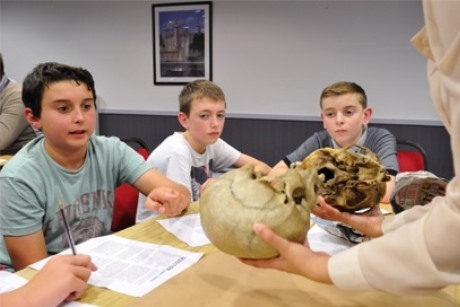
A look at the work Forensic Outreach does with schools.
Forensic Outreach runs schools workshops with a twist. Sessions take place in various London venues, such as the Science Museum, and occasional places outside the capital. Each workshop is based around the techniques used in crime scene investigations and security operations, and the content can touch on everything from Science to History and even Art.
Forensic Outreach's creative team all have post graduate scientific backgrounds and the company also consults with organisations like The US Department of Defence, the F.B.I, and the UCL Jill Dando Institute to develop its resources.
Some of its workshops can be booked through big school travel brands like WST and NST. Others can be booked directly.
Examples workshops
Fascinating Adventures in CSI
This session covers the history of crime scene investigation, the fundamentals of criminal investigation, and forensic techniques like blood spatter analysis, fibre analysis and finger printing. In order to learn, pupils will explore a mock-up crime scene and conduct a series of experiments using the data they collect and observe.
Saws and Scalpels, Poisons and Potions: Forensic Pathology and Toxicology
After warming up by analysing real autopsy photographs, students taking this session will be presented with an autopsy file of a deceased individual. They will then conduct a series of examinations to determine the cause and the manner of death in a mock case.
The Remarkable Journey of a Speeding Bullet
In this session pupils study ballistics and firearms in order to learn about Maths and Physics. They’ll shoot Nerf guns of varying sizes; calculate muzzle velocity; and analyse real bullet cartridges to compare and contrast them.
The Fantastic World of Frauds, Fakes and Facial Reconstruction: Forensic Art
Armed with paintbrushes and pencils, students in this workshop attempt to recreate some of the most renowned masterpieces of history. They will also test their skills at identifying fakes and manipulated images as well as attempt to reconstruct a face using just a skull.
Case study
In 2015 Forensic Outreach put on a CSI festival at the formerly named National Media Museum in Bradford. The company designed a narrative for the experience that involved the fictional murder of a local businessman. Visiting school students then had to explore the crime with the aid of five activity stations.
The first stop was a crime scene investigation where participants stepped into the shoes (and suits) of CSIs to examine the scene of the crime.
Following this, students had chance to learn the basic tenets and principles of crime scene photography as they got up close to key pieces of evidence.
Station three was an audio forensics station, where students analysed a voicemail left by the killer in order to determine which suspect left it.
The fourth stop was a ballistics station, which got students hands on with nerf guns, so that they could calculate the trajectory of a speeding bullet.
The session continued in a purpose-made lab, where pupils learnt more about blood and DNA analysis through live demonstrations from a real-life forensic scientists.
Finally, pupils visited trace evidence stations, where they attempted to recreate disturbing tool marks left at the crime scene before examining strands of hair and fibre found at the scene.
For more information about Forensic Outreach visit www.forensicoutreach.com.
(Photo credit: courtesy of NST Travel Group)










